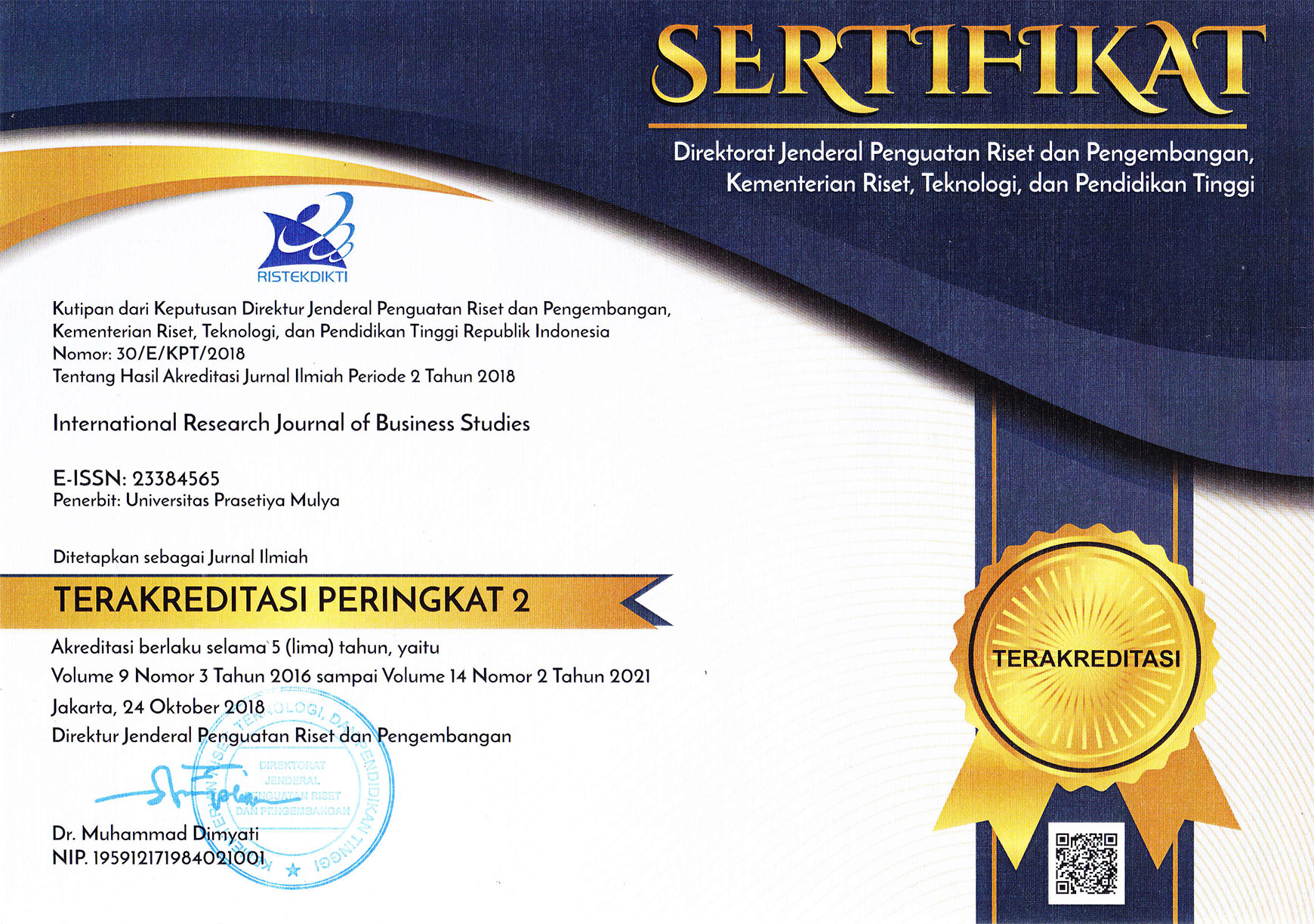Banking Accounting Practices “Humanist”
DOI:
https://doi.org/10.21632/irjbs.9.1.31-38Keywords:
Humanism, Bank accounting, Phenomenology, QualitativeAbstract
Humanism is a universal value that should be attached to all forms and operational activities of the bank because the bank’s main business is to provide service to humanity. The purpose of this study was to determine the humanist banking practice. The use of qualitative methods with a phenomenological approach that involve an account officer and marketing staff as key informants. In-depth interviews conducted to obtain comprehensive information. The results of the study informs that the banking practice in the lending and the funding activities were still oriented to material interests or to achieve maximum profit with unbalanced position. It caused the values of humanism in the form of truth and equitable negated by bank stakeholder. The results of this study also found that there are two forms of awareness is needed in the value of accountability in the process of funding and lending activities to customers humanistic were the awareness of responsibility to themselves and to God.
References
Anna, C. A., Norazlin, A. A., Normawati, N., & Rusnah, M. (2016). Sharia disclosures: An exploratory study from the perspective of Sharia-compliant companies and professional users. Journal of Islamic Accounting and Business Research, 7(3), 237 – 252.
Bassam, M., & Christopher, N. (2010) Accounting, religion and organisational culture: the creation of Jordan Islamic Bank. Journal of Islamic Accounting and Business Research, 1(2), 92 – 113.
Creswell, J.W. (1994). Research Design: Qualitative & quantitativee approach. Thousand Oaks, London, New Delhi: Sage.
Denzim, N. K., & Lincoln, Y. S. (2009). Handbook of qualitative research (translated). Yogyakara: Pustaka Pelajar.
Domènec, M., & Thomas, L. M. (2011). Humanistic corporate community involvement: Walgreens/MEF One‐On‐One program. Journal of Management Development, 30(6), 582-593.
Gallhofer, S., & Haslam. J. (2011). Emancipation, the spiritual and accounting. Critical Perspectives on Accounting, 22 (5), 500-509.
Haryanto. A. (2011). Desain Pembelajaran yang Demokratis & Humanis. Yogyakarta: Ar-Ruzz Media.
Hichem, H. (2013). Sharia governance in Islamic banks: effectiveness and supervision model. International Journal of Islamic and Middle Eastern Finance and Management, 6(3), 226-237.
Hidayat, R. (2014). Efisiensi Perbankan Syariah: Teori dan Praktik. Bekasi: Gramata Publishing.
Iwan, T. (2012). Akuntansi Syariah Perspektif, Metodologi, dan Teori. Jakarta: PT. Raja Grafindo Persada
Kabiru, J. R. (2014). Perception of Nigerian Muslim account holders in conventional bankstoward Islamic banking products. International Journal of Islamic and Middle Eastern Finance and Management, 7(3), 288-305.
Kun‐ho, L., & Lee, S. U. (2011). Customers’ attitude toward Islamic banking in Pakistan. International Journal of Islamic and Middle Eastern Finance and Management, 4(2), 131-145.
Mezbah, U. A., Uddin, A., Ruslan, S., & Romzie, R. (2016). A critique on accounting for murabaha contract: A comparative analysis of IFRS and AAOIFI accounting standards. Journal of Islamic Accounting and Business Research, 7(3), 190-201.
Scott, W. K. (2016). Retrospective: efficiency in service delivery: technological or humanisticapproaches? Journal of Services Marketing, 30(2), 133-135.
Sivakumar, V. (2014). “Conventional” accounting vs “Islamic” accounting: the debate revisited. Journal of Islamic Accounting and Business Research, 5(2), 126-141
Wasim K. A., & Muhannad, A. A. (2016). Profit-sharing investment accounts in Islamic banks or mutualization,
accounting perspective. Journal of Financial Reporting and Accounting, Volume: 14 Issue: 1, 30-48.
Downloads
Submitted
Published
How to Cite
Issue
Section
License
Copyright (c) 2016 Nanang Shonhadji

This work is licensed under a Creative Commons Attribution-ShareAlike 4.0 International License.
Journal Author(s) Rights
For IRJBS to publish and disseminate research articles, we need publishing rights (transferred from the author(s) to the publisher). This is determined by a publishing agreement between the Author(s) and IRJBS. This agreement deals with the transfer or license of the copyright of publishing to IRJBS, while Authors still retain significant rights to use and share their own published articles. IRJBS supports the need for authors to share, disseminate and maximize the impact of their research and these rights, in any databases.
As a journal Author, you have rights to many uses of your article, including use by your employing institute or company. These Author rights can be exercised without the need to obtain specific permission. Authors publishing in IRJBS journals have comprehensive rights to use their works for teaching and scholarly purposes without needing to seek permission, including:
- use for classroom teaching by Author or Author's institution and presentation at a meeting or conference and distributing copies to attendees;
- use for internal training by the author's company;
- distribution to colleagues for their research use;
- use in a subsequent compilation of the author's works;
- inclusion in a thesis or dissertation;
- reuse of portions or extracts from the article in other works (with full acknowledgment of the final article);
- preparation of derivative works (other than commercial purposes) (with full acknowledgment of the final article);
- voluntary posting on open websites operated by the author or the author’s institution for scholarly purposes,
(But it should follow the open access license of Creative Common CC-by-SA License).
Authors/Readers/Third Parties can copy and redistribute the material in any medium or format, as well as remix, transform, and build upon the material for any purpose, even commercially. Still, they must give appropriate credit (the name of the creator and attribution parties (authors' detail information), a copyright notice, an open access license notice, a disclaimer notice, and a link to the material), provide a link to the license, and indicate if changes were made (Publisher indicates the modification of the material (if any) and retain an indication of previous modifications.
Authors/Readers/Third Parties can read, print and download, redistribute or republish the article (e.g. display in a repository), translate the article, download for text and data mining purposes, reuse portions or extracts from the article in other works, sell or re-use for commercial purposes, remix, transform, or build upon the material, they must distribute their contributions under the same license as the original Creative Commons Attribution-ShareAlike (CC BY-SA).
This work is licensed under a Creative Commons Attribution-ShareAlike 4.0 International License.








